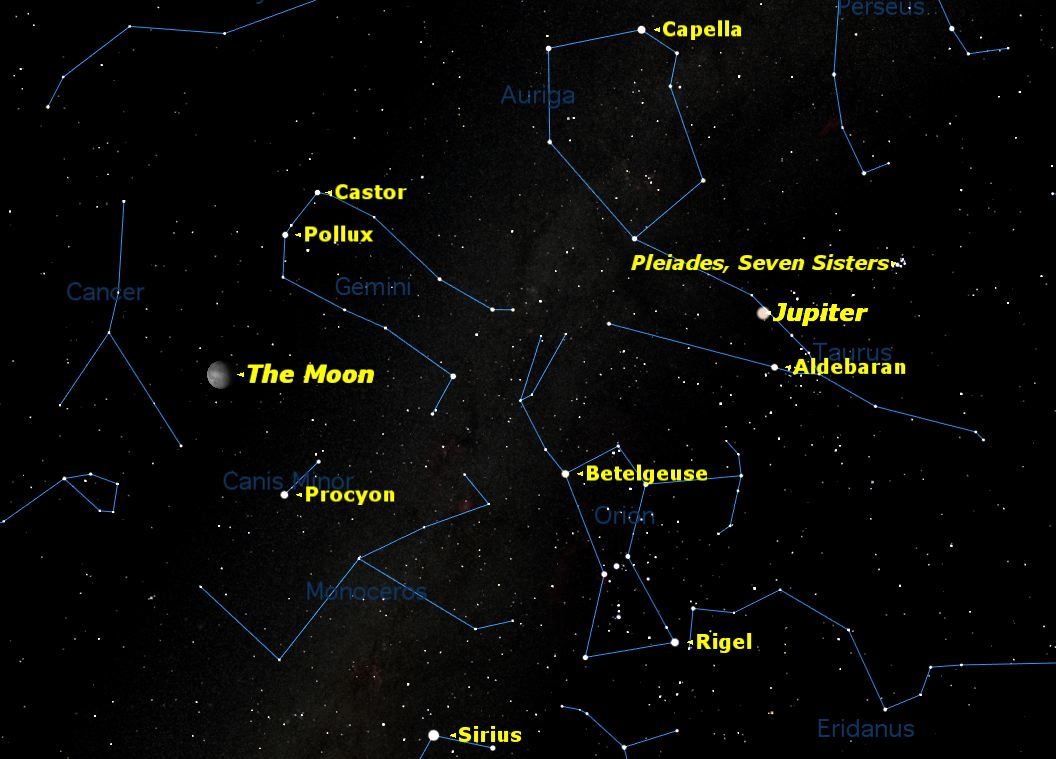LIVE Webcast Now: Jupiter Shines at Its Best Tonight

The biggest planet in the solar system, Jupiter, will be at its shining at its best tonight and you don't even need good weather to see the bright gas giant: you can catch the show online.
Jupiter is unmistakable in the night sky for stargazers with clear weather. The giant planet currently shines bright all night long, rising in the east as the sun sets and then setting in the west at sunrise. Tonight (Dec. 2), Jupiter will reach opposition, a point in the sky directly opposite the sun, making this a prime time to observe the planet.
If gazing at Jupiter with your unaided eyes or a small telescope doesn't satisfy you, the online Slooh Space Camera plans to broadcast live views of the planet from an observatory in the Canary Islands off the west coast of Africa. Like all skywatching events, the webcast is dependent on clear weather at the observing site.
If conditions are clear, the webcast will begin at 8 p.m. EST (0100 Dec. 3) and last 30 minutes. You can watch the webcast live below or from: http://events.slooh.com/
On opposition night, Jupiter will be visible in the constellation Taurus and shine above the horizon for 15 hours.
"Because Jupiter is above the horizon for longer than its rotation period, it is possible to watch an entire rotation of the planet in one night," Geoff Gaherty, an astronomer with Starry Night and SPACE.com skywatching columnist, explained in a December night sky guide.
Observers equipped with backyard telescopes may be able to see some of Jupiter's major features, including the planet's Great Red Spot —a colossal storm that has been seen on the planet since 1894.
Get the Space.com Newsletter
Breaking space news, the latest updates on rocket launches, skywatching events and more!
“The Red Spot is a permanent hurricane,” said astronomer Bob Berman of Astronomy Magazine in a statement. "Its violent rotation is encouraged by the high-speed winds screaming in opposite directions along its top and bottom most flanks, as the planet itself spins 24 times faster than our own world."
Berman will participate in the Jupiter webcast along with Slooh president Patrick Paolucci.
On opposition night, Jupiter will be about 378 million miles (608 million kilometers) from Earth, Slooh officials said. The planet's dark equatorial belts and yellow-white regions may be visible in good amateur telescopes, they added.
Editor's note: If you snap a photo of Jupiter at opposition, or any other night sky view, and would like to share it with SPACE.com for a story or gallery, send images, comments and viewing location information to managing editor Tariq Malik at: tmalik@space.com.
You can follow SPACE.com on Twitter @Spacedotcom. We're also on Facebook & Google+.
Join our Space Forums to keep talking space on the latest missions, night sky and more! And if you have a news tip, correction or comment, let us know at: community@space.com.

Space.com is the premier source of space exploration, innovation and astronomy news, chronicling (and celebrating) humanity's ongoing expansion across the final frontier. Originally founded in 1999, Space.com is, and always has been, the passion of writers and editors who are space fans and also trained journalists. Our current news team consists of Editor-in-Chief Tariq Malik; Editor Hanneke Weitering, Senior Space Writer Mike Wall; Senior Writer Meghan Bartels; Senior Writer Chelsea Gohd, Senior Writer Tereza Pultarova and Staff Writer Alexander Cox, focusing on e-commerce. Senior Producer Steve Spaleta oversees our space videos, with Diana Whitcroft as our Social Media Editor.









